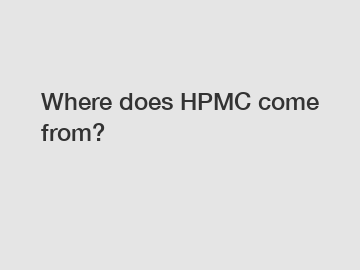Where does HPMC come from?
Have you ever stopped to wonder where the ingredients in your everyday products come from? One such ingredient that is commonly found in a variety of products is Hydroxypropyl Methylcellulose, or HPMC for short. But where does HPMC come from?
HPMC is a versatile and highly useful compound that is commonly used in the pharmaceutical, food, and construction industries. It is a semi-synthetic, water-soluble polymer derived from plant cellulose. The manufacturing process for HPMC involves treating cellulose fibers with a combination of propylene oxide and methyl chloride to create a cellulose ether derivative.
The cellulose used in the production of HPMC is typically derived from wood pulp or cotton linters. These raw materials are broken down into cellulose fibers, which are then treated with the propylene oxide and methyl chloride in a series of chemical reactions. This results in the creation of a compound with excellent thickening, film-forming, and water retention properties.

HPMC is a key ingredient in many products such as pharmaceutical tablets, ophthalmic solutions, food additives, and construction materials. In the pharmaceutical industry, HPMC is used to control the release of active ingredients in medications, ensuring that they are delivered to the body in a safe and effective manner. In the food industry, HPMC is used as a thickener, stabilizer, and emulsifier in a wide range of products such as sauces, dressings, and baked goods. In the construction industry, HPMC is used as a binder in mortar and plaster, as well as a thickener in paint and coatings.
One of the key properties of HPMC that makes it such a versatile ingredient is its ability to form gels and films when dissolved in water. This allows for a wide range of applications in various industries, including the production of controlled-release medications, gluten-free baking, and environmentally friendly construction materials.
HPMC is considered to be a safe and non-toxic compound, making it suitable for use in a variety of consumer products. It is easily biodegradable and does not accumulate in the environment, further adding to its appeal as an environmentally friendly ingredient.
In addition to its practical applications, HPMC is also a favorite among formulators and product developers for its ease of use and compatibility with a wide range of other ingredients. Its versatility and performance make it a valuable tool in creating innovative and high-quality products that meet the needs of consumers in today's market.
So, the next time you come across a product that contains HPMC, whether it be a medication, food item, or construction material, remember that this versatile compound is derived from plant cellulose through a complex manufacturing process. Its unique properties and wide range of applications make it an invaluable ingredient in a variety of industries, contributing to the development of safe, effective, and sustainable products for consumers around the world.
Want more information on hpmc manufacturer, hydroxypropyl methylcellulose powder, ceramic adhesives hpmc exporter? Feel free to contact us.

Comments
0